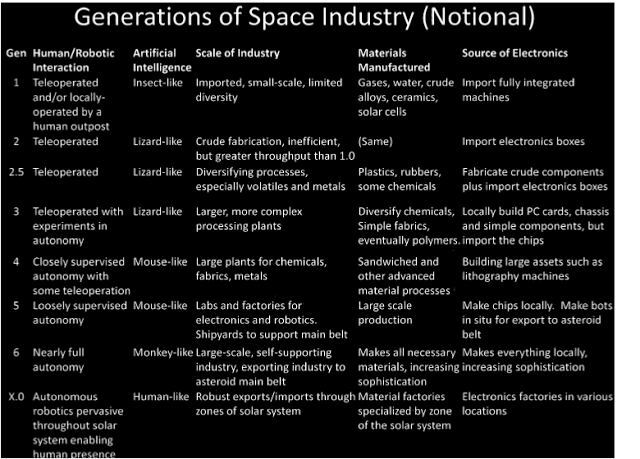UPDATE – 24 page preprint copy of the paper.
Nextbigfuture looked at the paper before when only the abstract was available.
ABSTRACT- Advances in robotics and additive manufacturing have become game‐changing for the prospects of space industry. It has become feasible to bootstrap a self‐sustaining, self‐expanding industry at reasonably low cost. Simple modeling was developed to identify the main parameters of successful bootstrapping. This indicates that bootstrapping can be achieved with as little as 12 metric tons (MT) landed on the Moon during a period of about 20 years. The equipment will be teleoperated and then transitioned to full autonomy so the industry can spread to the asteroid belt and beyond. The strategy begins with a sub‐replicating system and evolves it toward full self‐sustainability (full closure) via an in situ technology spiral. The industry grows exponentially due to the free real estate, energy, and material resources of space. The mass of industrial assets at the end of bootstrapping will be 156 MT with 60 humanoid robots, or as high as 40,000 MT with as many as 100,000 humanoid robots if faster manufacturing is supported by launching a total of 41 MT to the Moon. Within another few decades with no further investment, it can have millions of times the industrial capacity of the United States. Modeling over wide parameter ranges indicates this is reasonable, but further analysis is needed. This industry promises to revolutionize the human condition.
Key Ideas
• Don’t launch it; evolve it
• Not a simplistic “self-replicator”
-The biosphere and industry are not self-replicators
• Use “Appropriate Technology” at each step
– It doesn’t need to be low mass or high tech
– It needs to be easy to make in space
• The technologies are already being developed
-Simply “spin them in”
• The technologies are advancing exponentially
The Robosphere
• Like an Ecosphere
• Like a living cell
• Beautifies the solar system
• Allows us to live at the top of a food chain
• Enables us to do great things
– Terraforming, colonies
-Science, arts
Cost/Benefit
• Cost:
– Develop and launch 12 to 60 tons to Moon and operate it
for 20 years
– Launch costs will be negligible using newer capabilities
– Comparing to cost and mass of ISS, this will be less
expensive than ISS
• Most mass will be redundant hardware, not unique items
• Benefit
– Move from being a Type-1 to a Type-2 civilization
• Solve world economic problems
• Make our existence safe in the solar system
• Brilliant possibilities for the future
– Move toward a Type-3 civilization
• Extend human presence through the Milky Way
-Interstellar travel
If you liked this article, please give it a quick review on ycombinator or StumbleUpon. Thanks

Brian Wang is a Futurist Thought Leader and a popular Science blogger with 1 million readers per month. His blog Nextbigfuture.com is ranked #1 Science News Blog. It covers many disruptive technology and trends including Space, Robotics, Artificial Intelligence, Medicine, Anti-aging Biotechnology, and Nanotechnology.
Known for identifying cutting edge technologies, he is currently a Co-Founder of a startup and fundraiser for high potential early-stage companies. He is the Head of Research for Allocations for deep technology investments and an Angel Investor at Space Angels.
A frequent speaker at corporations, he has been a TEDx speaker, a Singularity University speaker and guest at numerous interviews for radio and podcasts. He is open to public speaking and advising engagements.




